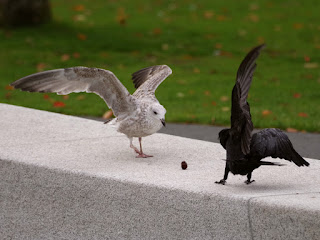An old friend is back, the Black-Headed Gull with ring number EY09813. It was ringed as an adult by Roy Sanderson in 2010 and has been on the Long Water every winter since then, on the posts in the Long Water at the Vista. As soon I came by it recognised me and flew over to catch bits of digestive biscuit in the air, clearly enjoying its agility.
I didn't mean to feed this Lesser Black-Backed Gull. I threw a peanut to a Carrion Crow and the gull grabbed it. Unlike a crow, it can't hold the nut down with its feet to peck it open, since gulls' feet are small and weak. So it crushed the shell with its strong beak to get the nuts out.
By the way, this is the Lesser Black-Back that is having a go at pigeon hunting on the south bank of the Serpentine.
Gulls don't always win. Someone threw a bread roll into the lake and a young Herring Gull took it.
But it was barged out of the way by a Mute Swan, which shook the roll to break it into pieces that could be swallowed.
In doing this, the swan dropped the roll, and the gull tried to grab it back, but the swan seized it again.
A Grey Heron which had been watching from the shore saw its opportunity and waded in to grab the roll from the swan.
And it was the heron which won in the end and ate the roll.
Here is another battle, this time for a toy, a conker (which for overseas readers is a horse chestnut seed). A young Herring Gull was playing with it in the rapids of the Diana fountain, and a Carrion Crow wanted it.
The gull came ashore and waved its toy at the crow.
The crow took off, flew round the back of the gull, and seized the conker.
But it dropped it. In the ensuing scuffle the conker fell into the water. The gull had therefore technically won, since it could retrieve the conker and the crow couldn't. But it decided that the game was no fun any more, and flew away.
A Cormorant on the island was playing with leaves, throwing them up in the air and catching them. Perhaps this is useful practice for catching fish.
A Great Crested Grebe scratched its ear with its foot.
A Jay looked at me expectantly.
I held up a peanut, and the Jay flew down and neatly took it from my fingers.
A Blackbird was shaking earth off a worm it had dug up.
A Long-Tailed Tit was looking for insects on a twig.
The Mistle Thrushes were on Buck Hill, some feeding in the grass and others eating rowan berries.

















Great action shots!
ReplyDeleteQuite remarkable, the Jay taking a peanut from your hand, isn't it? I think of them as rather shy, usually.I recall my father calling them 'policemen of the woods', as they seem to shout the alarm first, when something unpleasant enters the area- like a human.
It's taken a long time to get them to trust us enough. Now they enjoy the precise swoop and grab.
DeleteVery beautiful birds, close up. Always enjoyed (again, as a child) finding one of those bright blue-and-striped feathers. Not sure how I was so lucky to find those.
ReplyDeleteHave never seen a dropped Jay's feather. Quite likely that only the outer edge has the bright colour, and the inner edge is drab, as with parakeets and Egyptians.
DeleteMy elder brother was a bit of a woodsman, I suppose that may be how I came by the feathers. I do remember them as not being that long, but only blue & black striped. But does that make sense? Perhaps it was from young individuals who only just acquired wing feathers?
DeleteThat would be what you would expect from the appropriate part of the wing coverts.
DeleteNever a dull moment! What a wonderful set of action pictures.
ReplyDeleteIt was one of those days where a lot was happening.
Delete